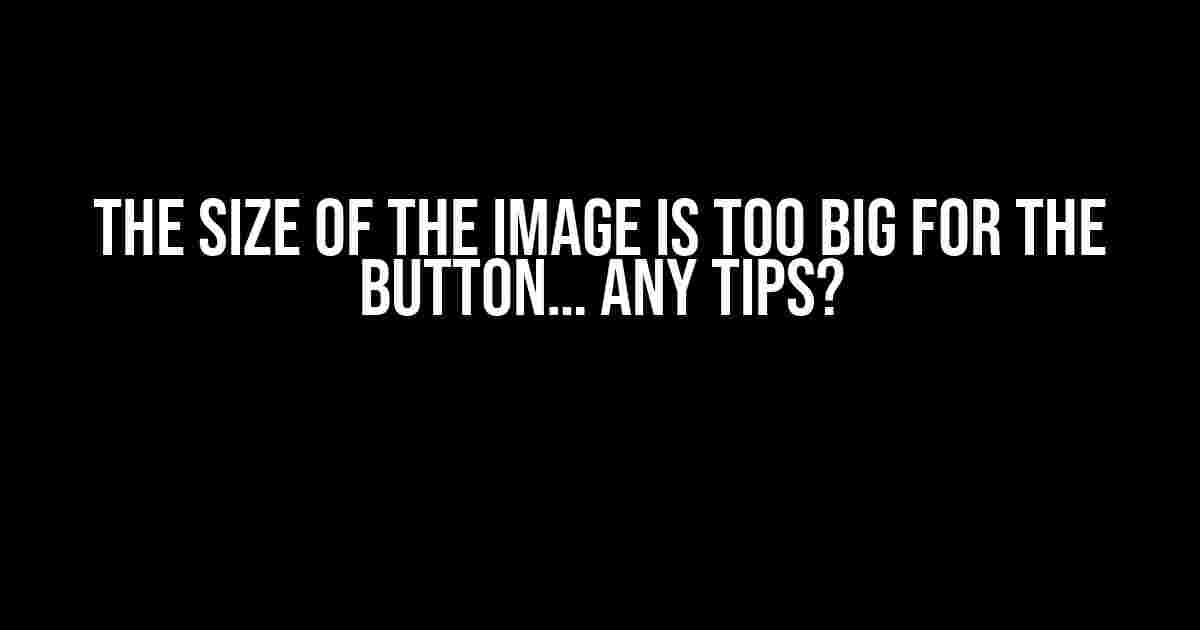Are you struggling to fit a large image into a small button? Do you find yourself constantly resizing and cropping, only to end up with a pixelated mess? Fear not, dear developer, for we’ve got the solutions for you! In this article, we’ll dive into the world of image sizing and explore the best practices for fitting those pesky images into tiny buttons.
Understanding the Problem
Password reset buttons, social media icons, and call-to-action buttons – they all require images, but what happens when those images are just too darn big? You can’t very well scale them down to fit the button, can you? (Spoiler alert: you can, but it’s not always the best approach).
Why Image Size Matters
Aside from aesthetics, image size affects three crucial aspects of your website or application:
- Page Load Time: Large images can significantly slow down page loading times, leading to frustrated users and higher bounce rates.
- SEO: Google takes page loading times into account when ranking websites. Slow sites = lower rankings = fewer visitors.
- User Experience: Cluttered, oversized images can overwhelm users, making it difficult for them to focus on the content that matters.
Image Sizing Best Practices
Before we dive into the nitty-gritty of image resizing, let’s cover some basic best practices to keep in mind:
- Use the Right File Format: For buttons, use PNG or GIF files. They’re ideal for graphics with transparent backgrounds. For photos, use JPG files, which offer better compression.
- Optimize Image Compression: Tools like TinyPNG or ImageOptim can reduce file sizes without sacrificing quality.
- Use Vector Graphics: When possible, use SVG files, which can be scaled up or down without losing quality.
Resizing Images for Buttons
Now that we’ve covered the basics, let’s explore some methods for resizing images to fit small buttons:
width: 100%; in your CSS is not always the answer. This method can lead to distorted images, especially if the aspect ratio is different from the button’s dimensions.
<img src="large-image.png" alt="Large Image" style="width: 100%; height: auto;">A better approach is to use the object-fit property, which allows you to scale the image while maintaining its aspect ratio:
<img src="large-image.png" alt="Large Image" style="width: 100%; height: 100%; object-fit: cover;">However, this method can still result in a distorted image if the button’s dimensions are significantly different from the image’s original size.
Image Cropping and Focusing
Sometimes, you just need to crop the image to focus on the important parts. This is especially true for button images, where a cluttered design can overwhelm the user.
Use image editing software like Adobe Photoshop or free alternatives like GIMP to:
- Remove unnecessary background elements
- Focus on the main subject
- Resize the image to fit the button’s dimensions
Remember to save the cropped image as a new file to avoid overwriting the original.
Button Design Considerations
While we’re on the topic of button design, let’s discuss some crucial considerations:
<button> elements should have a clear hierarchy and visual distinction from other elements on the page. Use:
- Contrasting colors
- Clear typography
- Iconography (when applicable)
A well-designed button should guide the user’s attention and encourage action.
Tools and Resources
Need help with image resizing, cropping, or optimizing? Check out these fantastic tools and resources:
| Tool | Description |
|---|---|
| TinyPNG | Compress PNG and JPG files without sacrificing quality. |
| ImageOptim | Optimize image files for web use, reducing file sizes and improving page load times. |
| Adobe Photoshop | Industry-standard image editing software for advanced image manipulation. |
| GIMP | Free and open-source image editing software for those on a budget. |
| Squoosh | Online image compression tool for reducing file sizes and improving page load times. |
Conclusion
The size of the image is too big for the button, but with these tips and tricks, you’re now equipped to tackle even the most challenging image resizing tasks! Remember to:
- Optimize image compression
- Use the right file format
- Resize images with care
- Crop and focus on important elements
- Design buttons with clarity and distinction
- Utilize tools and resources for assistance
By following these guidelines, you’ll be creating visually stunning buttons that enhance the user experience and boost your website’s performance.
So, go forth and resize those images like a pro!
Frequently Asked Question
Got a button, but the image is overwhelmed? Don’t worry, we’ve got you covered! Here are some tips to help you resize that image and make it button-perfect.
What’s the ideal image size for a button?
The ideal image size for a button depends on the design, but a general rule of thumb is to keep it under 100×100 pixels. This ensures that the image is clear, yet doesn’t overwhelm the button.
Can I resize the image using CSS?
Yes, you can resize the image using CSS! Use the `width` and `height` properties to set the desired dimensions. For example, `.button img { width: 50px; height: 50px; }` will resize the image to 50×50 pixels.
Will resizing the image affect its quality?
Resizing an image can affect its quality, especially if you’re using a raster image (like a JPEG or PNG). To avoid pixelation, use a vector image (like an SVG) or resize the image in an image editing software like Adobe Photoshop.
Can I use a background image instead?
Yes, you can use a background image instead! This can be a great way to add a visual interest to your button without overwhelming it. Use the `background-image` property in CSS to set the desired image.
What’s the best file format for a button image?
The best file format for a button image is a PNG or SVG. These formats offer transparency, crispness, and scalability, making them perfect for web design.
